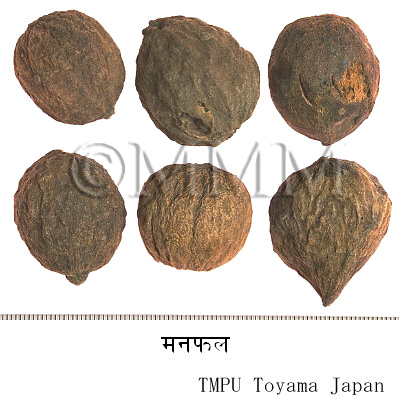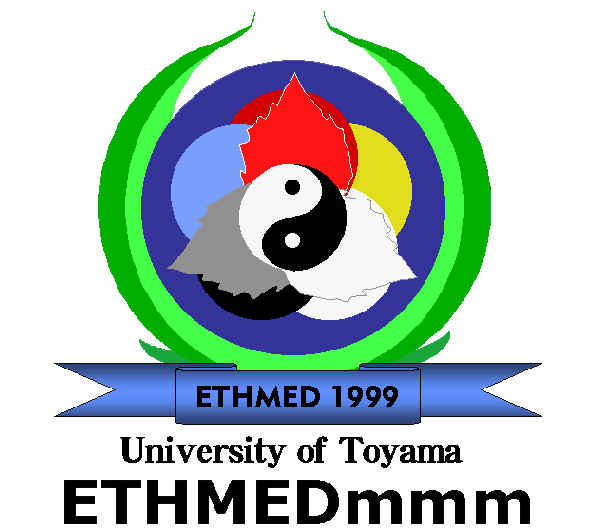Crude drug sample data base
※Click on the image to enlarge it.
Crude drug name | Market name | Manphal |
|---|---|---|
| Formal name | Madana | |
Other names Tips! | Madanphal (T), Memphal (B), Mainphal, Madan (H), Banegaru, Kare (K), Malankara (M), Manga, Marrga, Manda (Te), Madkarai (Ta), Maidal, Amuki (N), Kukuruman, Et-kukuruman (Sin) | |
| English name | Emetic Nut | |
| Original plant name | Catunaregam spinosa (Thunb.) Tirvengadum. (= Randia dumetorum (Retz.) Lam.), Emetic Nut | |
| Family name | Rubiaceae | |
| Used part | Classification | Plant origin | Sub classification | fruit |
| Collection information | India, New Delhi | |
| Collection date | 1991/05/07 | |
| Collector | Tsuneo Namba, et al. | |
| TMPW No. | 12425 | |
The capital city, provincial capital city or the representative
location of its administrative area is indicated.
location of its administrative area is indicated.
Production area information
https://ethmed.toyama-wakan.net/img/pin_san.png
28.6139391
77.20902120000005
Collection information
India,New Delhi
https://ethmed.toyama-wakan.net/img/pin_nyu.png
Scientific information data base
| Crude drug name | Ayurvedic name or Sanskrit name, English name | Madana, Emetic Nut | |||
|---|---|---|---|---|---|
| Synonyms | Radhaka, Vrttapatra, Kantaki, Vitapi, Rekhaphalam, Pindi, Karaghata, Salyakam, Jagalaphalam, Visapuspa, Svasana Pinditakah, Salyaka, Galaphalam, Galava, Kantala, Visamusti, Chardana, Ghandala, Harsa, Gandhakhya, Vastirodhana, Granthiphala, Golaphala, Maruvaka, Matula, Bijapuspaka | ||||
| crude drug image |
| ||||
| Original plant name | Catunaregam spinosa (Thunb.) Tirvengadum. (= Randia dumetorum (Retz.) Lam.) | ||||
| Family name | Rubiaceae | ||||
| Used part | Bark, Fruits | ||||
| Distribution area | Throughout India, upto 1350m. | ||||
| Remarks | Common. | ||||
| Common uses | This drug is anthelmintic, abortifacient, nervine, calmative and antispasmodic. It is used in the treatment of rhinitis, dermatosis, flatulence, dysentery, menorrhagia, piles and phlegmatic swellings. It is a suitable irritant-emeto-cathartic and is an excellent substitute for ipecac. It is ground to powder and applied to tongue and palate for fever and incidental ailments in children during teething. In smaller doses it is nauseant, expectorant and diaphoretic. | ||||
| Therapeutic uses | Vrana (wounds), Jvara (fever), Pratisyaya (running nose), Gulma (intestinal tumour/tumor), Antarvidradhi (internal neoplasms), Anaha (abdominal distension), Sopha (oedema), Arsa (piles) | ||||
| Chemical constituent | - The fresh fruit contains 2 to 3% saponins (c 10% in dried whole fruit), concentrated mostly in the pulp. Ethanolic extract of the fruit yielded glycosides and glucosides. - Seeds contain an essential oil (0.6%), an organic acid (1.4%), an alkaloid and oleanolic acid 3-β-glucoside. Seeds also contain proteins (14.2%), and a fat (1.5%), known as Randia fat. | ||||
| Pharmacological effect | Alcoholic extract of the fruit exhibited anti-implantation activity in albino rats and a marked anti-ovulatory activity in rabbits. It also showed hypoglycaemic and anti-cancer activities. Essential oil from seeds shows significant anti-bacterial and anti-fungal activities. It also possesses anthelmintic properties comparable to that of piperazine citrate against tapeworms. The glucoside showed anti-implantation activity (75 to 100%) in albino rats; it is anti-oesterogenic in nature. It also exhibits anti-inflammatory activity in both exudative and proliferative phases of inflammation, and significant analgesia on thermal stimulus. | ||||
| Medical system | Ayurveda (Traditional Indian medicine) | ||||
| Traditional concept | Rasa (Taste) | Katu (Pungent), Tikta (Bitter), Madhura (Sweet), Kasaya (Astringent) | |||
| Virya (Potency) | Usna (Hot) | ||||
| Guna (Quality) | Ruksa (Dry), Laghu (Light) | ||||
| Vipaka (Post digestive taste) | Katu (Pungent) | ||||
| Prabhava (Special action) | Vamana (induces vomiting) | ||||
| Karma (General action) | Lekhana (scraping), Vantikrt (induces vomiting), Anulomana (causing downward movement of Vayu) | ||||
| Traditional usage | 1. Madana (Catunaregum spinosa) is regarded as the best emetic drug because it is free from complications. It is particularly useful in cases of fever, intestinal tumour/tumor and coryza caused by Kapha. 2. Madana mixed with Pippali (Piper longum), Indrayava (Holarrhena pubescens) or Madhuka (liquorice) should be given without water for inducing emesis in fever. 3. Madana pounded with sour gruel is applied as paste on naval. It removes pain. Similarly does the paste of Jivanti (Leptadenia reticulata) root mixed with oil. 4. Intake of powder of Madana and Pinditaka (Meyna laxiflora) seeds in dose of 10 gm pounded with water alleviates epilepsy. 5. Vagina should be fumigated with slough of black snake or Madana for difficult labour. | ||||
| Formulation | Pippalyadi taila | ||||
| Comments | Used for inducing vomiting and medicated enema. This is included in Vamana, Phalini groups of Caraka and urdhvabhagahara, Aragvadhadi, Muskakadi gana of Susruta. | ||||
| References | Reference book Tips! | [2] Indian Medicinal Plants - A Compendium of 500 species, Varier, P.S., Orient Longman Ltd. Chennai (Madras) Vol. 2 (Repr.1997), pp 33-36. Glossary of Indian Medicinal Plants, 1956. Chopra, R.N., Nayar, S.L. and Chopra, I.C., Council of Scientific & Industrial Research, New Delhi. - New Edition (1996) National Institute Science Communication; Supplement p 209. Illustrated Manual of Herbal Drugs Used in Ayurveda, 1996. Sarin, Y.K., Council of Scientific & Industrial Research and Indian Council of Medical Research, New Delhi p 266. The Ayurvedic Pharmacopoeia of India, Part I, Vol I, Ed. I, 1989. Govt. of India, Ministry of Health & Family Welfare, Dept. of Health, New Delhi p 84. Plants in Ayurveda (A Compendium of Botanical and Sanskrit Names), 1997. Abdul Kareem, M., Foundation for Revitalisation of Local Health Traditions, Bangalore 357. Dravyagunavijnana, Vols. 1-5, reprint 1998. Sharma, P.V., Chowkhambha Bharati Academy, Varanasi Vol. 2, pp 376-379. Classical uses of Medicinal Plants, 1996. Sharma, P.V., Chaukhambha Visvabharati, Varanasi p 283. | |||
| Remarks | Fruit possesses piscicidal, insecticidal and insect repellent properties. Seeds are used as tonic to induce appetite. Their decoction is taken for relief from headaches. Essential oil from seeds has anthelmintic property, comparable to that of Piperazine citrate against tapeworms. Owing to high saponin content and haemolytic/aemolytic index (8.540) of the fruits, further investigation on their possible use as expectorant and as a substitute for roots of Polygala senega L. has been suggested. | ||||
| Last renewal date | 2023/12/08 | ||||



